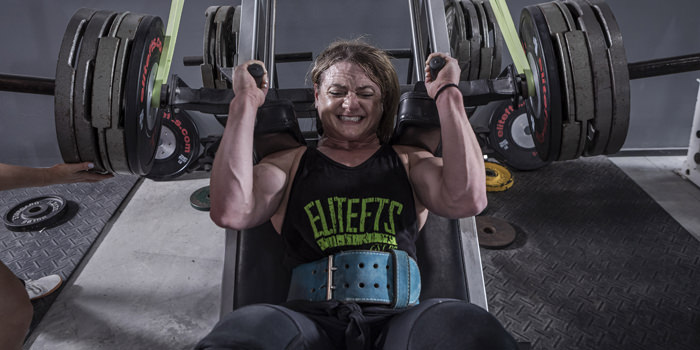
You leaped into the land of max effort and speed work. It seems pretty straightforward, but to your surprise, you're losing pounds off your lifts faster than you can say, "overspeed eccentrics."
All the articles about conjugate talk about breaking records every week, but you see no records.
But fret not if you are stuck or have given up altogether; you may find yourself making one of these major mistakes keeping you from the progress that the conjugate gods have promised.
Remember, there is always time to course correct.
1. You Let Your Strength Become a Weakness
No matter what your programming has looked like in the past, you have strengths and weaknesses in every lift you do. That's precisely why conjugate training specifically targets weak lifts and body parts.
If your hamstrings aren't pulling their weight, you push them up through conjugate; it is just that simple. The key is not letting your strength slip while trying to bring up your weakness.
Maybe you came from a close stance squatting background and switched to wide stance box squats. With less quad work in the main movement and focus on the weaker hamstrings, you initially set yourself to go backward. However, you might find yourself ignoring as much direct quad work because the hamstrings are the focus in conjugate. If you keep your quads strong but strengthen your back and hamstrings, your squat will go up!
You may also be changing your lifting technique. For instance, if you went from a close stance free squat (quad focused) to a wider stance box squat (hamstring focused), that change in technique will naturally push the weaker muscle to do more work. If done correctly.
There is a mental factor that can't be ignored when making significant technical changes. Keep the strong parts strong while bringing up those weaker parts. Know that a few steps backward may be inevitable initially, but don't let your current strengths weaken.
2. You Didn't Make It Your Own
The beauty of the conjugate system is that it can work for everyone. However, that is only if you tailor it to your specific needs.
If you follow your training partner's program or use a stock program, you might see some improvement, but not enough to keep you interested in the conjugate system. From an aerial, big-picture perspective, they will look the same via max effort, dynamic effort, and the repetition method. But up close, there can be quite a bit of variability.
Louie put together and simplified the conjugate method, but you own your program. Body structure, temperament, training history, training age, and injury history are all highly individualized factors that must be addressed. There are many humans, but we all look and act slightly differently. That is how your version of the conjugate system will look. Yet your program must also be fluid and adaptable. What you need today may differ from what you need in two years.
Some patterns may repeat, but as you evolve, so must your training. You may need to try different things, and that will require time. Only you can determine what is best.
Take notes and learn as you go.
3. You Didn't Give It Enough Time
There are pieces in the conjugate system that can help you peak, as I wrote about in the book about the squat cycle. Overall though, the conjugate system is both a short and long-term plan. Therefore, you should be looking at both the micro and macro levels.
You should have daily, weekly, monthly, six-month, and yearly plans. Looking multiple years into training is also essential. The further you look, the blurrier that gets, but understand that this system is not just a short-term plan. Some training takes weeks or months to get to where you can see and feel the progress.
Some training will build the exercises in the next cycle. You can't see it yet, but you must be prepared to do the next block of harder work. Laying a foundation requires you to build over time. You can't just max effort your way to new records. You must raise your general physical preparedness enough to do and recover from more work to break new maxes. Like building a wall, you must do it one brick at a time. You must also know where the wall will be in the future.
4. Too Much Testing and Not Enough Building
The max effort day (e.g., taking singles) is one of the best parts of the conjugate system. However, both max effort and dynamic effort work should be less than 20% of all the work you do. If you spend more of your focus on those two areas rather than letting them be the indicators of how the other 80% is being addressed, you are making a significant mistake.
Assistance work moves your supplemental work. The supplemental work (when chosen correctly) builds your max effort and dynamic effort work. Of course, you want to work hard during your max effort and dynamic effort work, but technical work and CNS stress will also make neural improvements.
Just remember, you can only drive a car so fast, and at some point, you need better parts. Too much testing and not enough building will halt progress almost as quickly as poor technique.
5. Your Technique Sucks
Improvements in technique are the fastest way to improve numbers. If your technique sucks or breaks down early in the lift, you can't properly display the hard work you have put into building better parts. Some technical improvements can come from addressing weak points, honest feedback from coaches and other lifters, changes in sequences (open knees before sitting back), or technical overhauls due to injury or body structure.
Every rep is a feedback loop. Dynamic effort work is your technical day, and with each wave, you should notice improvements. As you become more advanced, you will dial in your technique and build the parts to support that technique.
Don't make an excuse that it is just how you do it. We all know there is some variance, but most with poor technique don't last long. Constant improvement over the years will lead to the biggest numbers.
6. You Made It Too Complicated
The conjugate system has many interchangeable cycles and parts, but it doesn't need to be complicated. Conjugate is not bands, chains, or specialty bars. Those are tools to help address weaknesses and accommodating resistance.
A barbell, plates, squat rack, and bench are all you need to get started. Weight releasers, circa max, lactic acid tolerance training, and everything you have read about are accessories to the tried and true conjugate system.
eBook: Maximal Training with Minimal Equipment: Bare Bones Conjugate Training
As beneficial as box squatting is, you don't even have to do that. So stop trying to make things extra conjugate. Do the basics better than most everyone, and you will be better than most everyone.
If you know physical, technical, and mental weak points, you can train to improve those. However, if you don't know where to focus, you will get overly complicated and throw everything against the wall to see what sticks.
7. You Didn't Know Your Indicators
I'm sure you've heard of builders and testers. The builders are the exercises you use to add muscle and pounds to your lifts. The testers show you that you are gaining ground, losing ground, or your strength in that lift is high enough to break a record. If you don't know what those are, then you are just guessing in training.
Knowing this will allow you to effectively look at each workout and make adjustments going forward. This is the difference between following a program while hoping for the best at the end and a system that will help you make corrections. Take ownership and learn what makes your lifts go up and why.
Conclusion
I love the conjugate system for many reasons. First, it's so simple to start. Breaking each piece down, there is so much to learn. If you're struggling with the conjugate system, it will be alright. You might be missing something small that can skyrocket your lifts. Don't give up. Just keep looking for answers.

Matt Ladewski has been involved in the sport of powerlifting for over 20 years. As his pursuit of bigger numbers of his own has concluded, his attention has shifted to coaching his athletes, including a WPF and an AWPC champion. As a columnist for elitefts, Matt shares his training knowledge and experience as he writes about both his own training and the coaching of his athletes. Matt's best competition lifts include an 835-pound squat, a 550-pound bench press, and an 800-pound deadlift.









